Op amps. Often the first thing that many learn about when beginning the journey into analog electronics, they’re used in countless ways in an overwhelmingly large array of circuits. When we think about op amps, images of DIPs and SOICs spring to mind, with an incredibly tiny price tag to boot. We take their abundance and convenience for granted nowadays, but they weren’t always so easy to come by.
[Mr Carlson] serves up another vintage offering, this time in the form of a tube op amp. The K2-W model he acquired enjoyed popularity when it was released as one of the first modular general purpose amplifiers, due to its ‘compact form’ and ‘low price’. It also came with large application manuals which helped it to gain users.
In order to power up the op amp and check its functionality, +300V and -300V supplies are needed. [Mr Carlson] is able to cobble something together, since it’s very apparent that he has an enviable stash of gear lying around. A 600V rail to rail supply is not something to be taken lightly, though it does give this particular model the ability to output 100V pk-pk without any distortion.
The op amp is set up as an inverting amplifier, and once powered on proves to work flawlessly. As always, the video is an entertaining watch, stuffed full of retro electronics trivia. We’re big fans of [Mr Carlson]’s work, and have previously written about his adventures with a colossal walk-in AM radio transmitter, as well as his restoration of a 1930s oscilloscope and subsequent transformer de-potting.















Looks like these are similar tubes? https://www.youtube.com/watch?v=Imsc_J25QmE
Someone once gave me an op-amp, but it was a module, the size of a matchbox. So no tubes, but neither was it an IC , it was in between.
Michael
Discrete op amps like the Melcor 1731 and API 2520 were common in a lot of high-end pro audio equipment from the 60’s onward. Most designs were utilizing IC op amps by the 80’s, but you can still find the discrete counterparts in current production units. Here’s some info on the API op amp and some of its applications:
http://www225.pair.com/audio/waltzingbear/Schematics/API.html
That was likely an early Burr-Brown opamp constructed using discreet transistors. Look at almost any opamp datasheet and you can see a representation of the circuit in transistorized form.
Oh! The yellow thing _IS_ the OP Amp!
I was told in tech school that before the 741, OP Amps were huge cabinet monsters…
They did have racks full of them to make analog computers, of which I own a couple. The MAN for Philbrick Op Amps is Joe Sousa, featured here before for his soup can transmitter IIRC – but Joe’s done a lot of very cool stuff. Even a Russian NOS tube reflex superhet radio that runs off a 9v battery and generates the HV for the audio output with the local oscillator.
The Philbrick Archive is here for anyone who wants to see the diversity of what was – more than you might expect.
http://www.philbrickarchive.org/
The app notes might be of special interest as many clever ways of getting something done with fewer parts are presented – back in the day, this mattered a lot more. And with today’s improved opamps, well…
My head professor and mentor at Auburn was Dr. Howard E. Carr. His course in Electronics was heavy on op amps, which in those days were all done with tubes. After he led the construction of the Uranium separators at Oak Ridge, he worked with the U.S. Navy, developing fire-control systems. I was fascinated by the op amp, and designed quite a number of audio circuits based on them. For the audio aficionados among us, the Baxandall tone control circuit is an op amp.
In 1956 Heathkit came out with an analog computer kit. It had 15 op amps with three tubes each, and a plugboard that would drive any telephone operator insane. I got the distinct privilege of building the thing. If you’ve ever built a Heathkit, you’re familiar with the instruction, “Prepare a shielded cable 15″ long. Cut the insulation back 1 1/2″ on one end, and twist the shield into a pigtail, etc., etc.” But you’ve probably never read “Now prepare 99 more.”
Here’s a link, which shows the computer, and even the schematic of the op amp.
http://s3data.computerhistory.org/brochures/heath.analog.1956.102646297.pdf
Jack
Cool brochure!
What’s this with “accuracy of better than 1/10 of 1%” used repeatedly in the text. Decimal fractions of percentages were not yet invented?
It’s simply marketing-speak for 0.1%. Makes it sound more impressive.
Another excellent presentation, thank you. The balancing of the positive and negative power supplies is not critical since the open loop gain is actually quite large and the closed loop gain you selected is quite small. The distortion only started at about 150V p-p (which is huge by transistor IC standards). I expect if the positive power supply rail was increased to 350V (say), that the peak-to-peak output could be increased by another 50V.
A Philbrick tube op amp used to drive a hybrid MOSFET output amplifier. Recent listing on eBay: Listing No. 374 962 285 877, may be an interesting application for vacuum tube op amp?